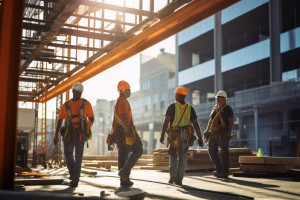 Working in the construction industry is a dangerous job. Workers are often at risk of falling from heights or being injured by equipment. In fact, according to the Centers for Disease Control and Prevention, “Falls remain the leading cause of work-related deaths in construction, accounting for more than one in three (36.4%).”
Working in the construction industry is a dangerous job. Workers are often at risk of falling from heights or being injured by equipment. In fact, according to the Centers for Disease Control and Prevention, “Falls remain the leading cause of work-related deaths in construction, accounting for more than one in three (36.4%).”
There are many potential hazards that can lead to a fall on a construction site, such as unprotected edges, uneven surfaces, holes in the ground, and loose materials. Falls can also happen when workers are not using proper safety equipment or if they are not following safety protocols.
The best way to prevent falls is to identify and address the hazards that exist on a construction site. This can be done through regular safety inspections and by implementing safety protocols that all workers must follow. Additionally, providing workers with proper safety training and equipment can help to reduce the risk of falls.
Personal fall arrest systems (PFAS) have harnesses designed to protect construction workers who are working at heights of six feet or more from serious injury and death. It’s also important to note that safety gear is situation-specific. In many fatal accidents, workers did not have appropriate safety gear for the work they were performing at the time. To protect these workers, employers must provide fall protection and the right equipment for the specific job or situation, including the right kinds of ladders, scaffolds, and safety gear. Some simple safety measures can go a long way in preventing falls and saving lives.
All workers should be educated on the risks, the potential hazards at a job site, and how to avoid them. However, even the right equipment in the right situation will not provide protection for construction workers if it is not used correctly. Therefore, in addition to using the right safety equipment, construction workers must also be properly trained in how to use that equipment. OSHA provides these tips for ladder, scaffold, and roof safety along with these safety materials and resources for employers to train their employees to become aware of fall dangers.
When it comes to preventing falls on construction sites, a lot of the focus is on the individual worker. But it’s also important to create a culture of safety on the job site. One way to do this is by having regular safety meetings. At these meetings, you can go over the specific fall hazards at your job site and how to avoid them. You can also review your safety policies and procedures and make sure everyone is on the same page. Another way to improve fall prevention is by creating a system for reporting near-misses and accidents. This way, you can identify potential hazards before they cause an injury. Finally, it’s important to encourage workers to speak up if they see something unsafe. By creating an open line of communication, you can help make your job site safer for everyone.
The threat of falls should be treated with the same caution as a structural engineer treats the foundation of a building: as a critical point of safety that bears the weight of the entire operation. Falls are not just the leading cause of accidents on construction sites, but they are also markers of potential systemic issues within safety protocols. A fall can indicate a lapse in adherence to safety standards or a lack of effective training. When a worker falls, it’s not just a tragic accident; it’s a plummet in team morale, a possible decline in the project timeline, and, of course, a significant financial strain from workers’ compensation claims, potential litigation, and increased insurance premiums. As business leaders, it’s imperative to construct a robust safety network that includes regular training, comprehensive risk assessments, and a culture where every employee is an accountable steward of their own and their colleagues’ safety. The foundation of a safe work environment is only as solid as its commitment to preventing falls.








